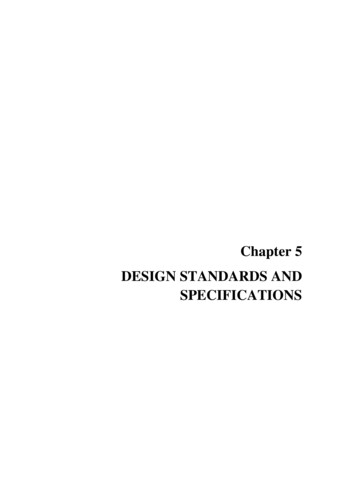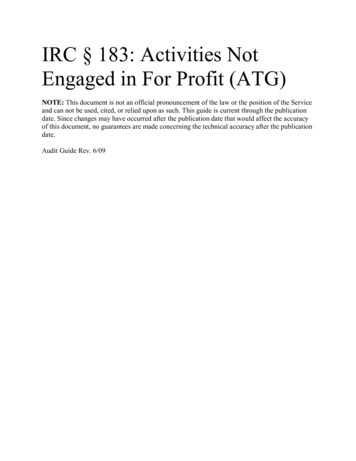
Transcription
IRC § 183: Activities NotEngaged in For Profit (ATG)NOTE: This document is not an official pronouncement of the law or the position of the Serviceand can not be used, cited, or relied upon as such. This guide is current through the publicationdate. Since changes may have occurred after the publication date that would affect the accuracyof this document, no guarantees are made concerning the technical accuracy after the publicationdate.Audit Guide Rev. 6/09
ContentsChapter 1: Introduction and Overview . 1Purpose of Guide. 1Objectives of Guide . 1IRC § 183 Overview . 1Multiple Activities . 5Farming Activities and Farmland Appreciation . 5Taxpayer’s Subject to IRC § 183 Activities Not Engaged in For Profit . 6Presumption that Activity is Engaged in for Profit . 7Election to Postpone Determination . 8Chapter 2: Examination Techniques . 11Examination Techniques Overview . 11Pre-audit Analysis . 11Information Document Request . 12Initial Interview . 12Place of Examination . 14Business/Activity Tour . 14Factual Development . 15Income Tax Savings Benefit Analysis . 17Chapter 3: Supporting Law . 18Internal Revenue Code . 18Treasury Regulations . 19Revenue Rulings . 20Case Law . 20Chapter 4: Report Writing . 21Calculating the Examination Adjustments under IRC § 183 . 21Incorrect Computation Example . 22IRC § 183(b) Computation Example . 23RGS Input . 25Partnerships, S Corporations, Trusts and Estates. 28Taxpayer Penalties . 30Return Preparer Penalties. 33IRC § 6694(a) Understatement Due to Unreasonable Positions . 34Unagreed Reports. 37Alternative positions . 38Inadequate Books and Records . 38Appendix . 40Appendix A - Treas. Regs. § 1.183-2(b) . 40Factor 1 . 40Factor 2 . 42Factor 3 . 43Factor 4 . 44Factor 5 . 46Factor 6 . 46Factor 7 . 47
Factor 8 . 49Factor 9 . 50Appendix B - Suggested Interview Questions for Each of 9 Relevant Factors . 51Appendix C - Tax Savings Benefit Analysis . 57Appendix D - Comparative Analysis Income, Expense and Losses . 58Appendix E - Example of an IDR for a Yacht Charter Activity . 60
Chapter 1: Introduction and OverviewPurpose of GuideThis audit technique guide (ATG) has been developed to provide guidance to Revenue Agentsand Tax Compliance Officers in pursuing the application of Internal Revenue Code (IRC) § 183,Activities Not Engaged in for Profit (sometimes referred to as the “hobby loss rule”).The purpose of the guide is to: assist in distinguishing between a business activity (where deductions may be allowableunder IRC § 162); a non-business “for profit” activity (where deductions may beallowable under IRC § 212; an activity not engaged in for profit (where deductions arestrictly limited by specific rules contained in IRC § 183); and a personal activity (wheredeductions are generally disallowed by IRC § 262, except to the extent not otherwiseallowable),provide examination techniques,supply applicable law, andprovide written guidance in report writing.This guide is not designed to be all inclusive.This guide is not legal precedent and should not be relied upon as such. It is not designed toremove the discretion given to managers and examiners in the application of a variety of audittechniques or procedures appropriate to any given examination.Objectives of GuideUpon completion of this audit techniques guide, the examiner will be able to:1. Determine when and to whom IRC § 183 may be asserted,2. Identify and develop relevant factors for making an IRC § 183 determination, and3. Compute the examination adjustments when a determination is made that an activity isnot engaged in for profit.IRC § 183 OverviewA number of taxpayers who have significant income from other sources reduce their taxableincome by reporting losses from activities that may or may not be engaged in for profit. It is upto IRS examiners to make a factual determination whether an activity is engaged in for profit.On September 27, 2007, the Treasury Inspector General for Tax Administration (TIGTA) issueda report entitled “Significant Challenges Exist in Determining Whether Taxpayers WithPage 1 of 64
Schedule C Losses are Engaged in Tax Abuse.” The review looked at high income SmallBusiness/Self-Employed (SB/SE) taxpayers (total income sources of 100,000 or greater) whoclaimed business losses using a U.S. Individual Income Tax Return (Form 1040) Profit or LossFrom Business (Schedule C) for activities considered to be not-for-profit. The results of the auditfound the following:“In general, if a taxpayer has hobby income and expenses, the expense deductionshould be limited to the hobby income amount. About 1.5 million taxpayers,many with significant income from other sources, filed form 1040 Schedules Cshowing no profits, only losses, over consecutive Tax Years 2002 – 2005 (4years); 73 percent of these taxpayers were assisted by tax practitioners. Byclaiming these losses to reduce their taxable incomes, about 1.2 million of the 1.5million taxpayers potentially avoided paying 2.8 billion in taxes in Tax Year2005. Changes are needed to prevent taxpayers from continually deducting lossesin potentially not-for-profit activities to reduce their tax liabilities.”It is important to note that the report limited their review to Schedule C’s with four years ofconsecutive losses and to total income sources of 100,000 or greater. It did not cover ScheduleF farm activities nor did it cover any type of entity other than the 1040.IRC § 183 generally limits deductions, in the case of an activity engaged in by a taxpayer, if theactivity is not engaged in for profit. The term “activity not engaged in for profit” is defined byIRC § 183(c) to mean any activity, other than one with respect to which deductions are allowablefor the taxable year under IRC § 162 or under paragraphs (1) or (2) of IRC § 212. IRC § 183applies to individuals, partnerships, S corporations, trusts and estates. It does not apply to Ccorporations.The determination of whether an activity is an activity not engaged in for profit is a factualdetermination. Neither the Code nor the Regulations provide an absolute definition. They insteadserve to provide guidance in formulating the facts necessary to determine whether an activity is anot for profit activity. Historically, IRC § 183 has been a difficult issue to pursue.The first “hobby loss” provision in the Internal Revenue Code was enacted by the Revenue Actof 1943 as IRC § 270. The act was intended to limit the ability of individuals with multiplesources of income to apply losses incurred in “side-line” diversions to reduce their overall taxliabilities. IRC § 270 was repealed by the Tax Reform Act of 1969 effective for tax yearsbeginning after December 31, 1969, and replaced with IRC § 183.Generally, the Code allows individuals to deduct expenses which are incurred (1) in a trade orbusiness (IRC § 162); or (2) for the production or collection of income, or for the management,conservation or maintenance of property held for the production of income (IRC § 212).For the expenses to be deductible under IRC §§ 162 or 212, the taxpayer must engage in or carryon an activity to which the expenses relate with an actual and honest objective of making aprofit. Keanini v. Comr., 94 T.C. 41 (1990) (citing Golanty v. Comr., 72 T.C. 411, 425 (1979),Page 2 of 64
aff’d without published opinion, 647 F.2d 170 (9th Cir. 1981)); Dreicer v. Comr., 78 T.C. 642(1982), aff’d without opinion, 702 F.2d 1205 (D.C. Cir. 1983).Taxpayers bear the burden of proving that they engaged in the activity with an actual and honestobjective of realizing a profit. Hendricks v. Comr., 32 F.3d 94 (4th Cir. 1994), aff’g T.C. Memo1993-396, Comr. v. Groetzinger, 480 U.S. 23, 35 (1987); Bot v. Comr., 353 F.3d 595, 599 (8thCir. 2003), aff’g 118 T.C. 138 (2002); Am. Acad. Of Family Physicians v. U.S., 91 F.3d 1155,1157-58 (8th Cir. 1996).The taxpayer must devote time to the business in the honest belief that the business willsometime in the future become profitable. It is necessary for the taxpayer to show what theirprojected profit is expected to be.If an activity is not engaged in for profit, IRC § 183(b) allows a taxpayer the deductions thatwould be allowable without regard to whether or not the activity is engaged in for profit. If thegross income derived from the activity for the taxable year exceeds these deductions, IRC §183(b) also allows a taxpayer to deduct the amounts that would be allowable as deductions if theactivity were engaged in for profit, to the extent of any remaining gross income.Treas. Regs. § 1.183-1(e) provides that for purposes of IRC § 183, gross income includes thetotal of all gains from the sale, exchange or other disposition of property and all other grossreceipts derived from such activity. It also provides that gross receipts from the activity may bereduced by cost of goods sold to determine gross income.It is generally to the taxpayer’s advantage to determine gross income based on gross profit (grossreceipts less cost of goods sold). The examiner should ensure that cost of goods sold is reducedby any personal expenses or nondeductible items prior to making the gross income computation.Making a determination as to whether an activity is not for profit has more implications thanwhether the loss will be allowed to offset other income. Many other areas on the tax return canbe affected by this determination including but not limited to: self-employment taxdeductions for health insurance premiumsalternative minimum tax (AMT)itemized deductionsadjusted gross income (AGI)personal exemption phase outRoth IRA contributionsThe determination of the proper amount of adjusted gross income can affect many items on thereturn, including but not limited to rental losses, medical expenses, casualty losses,miscellaneous deductions, the adoption expense credit and interest on education loans.Page 3 of 64
Also, when there is an IRC § 183 problem, the taxpayer may be subject to AMT sincemiscellaneous itemized deductions (where many not for profit expenses end up) are notdeductible for AMT purposes.Whether or not an activity is presumed to be operated for profit requires an analysis of the factsand circumstances of each case. Deciding whether a taxpayer operates an activity with an actualand honest profit motive typically involves applying the nine non-exclusive factors contained inTreas. Reg. § 1.183-2(b). Those factors are:1.2.3.4.5.6.7.8.9.the manner in which the taxpayer carried on the activity,the expertise of the taxpayer or his or her advisers,the time and effort expended by the taxpayer in carrying on the activity,the expectation that the assets used in the activity may appreciate in value,the success of the taxpayer in carrying on other similar or dissimilar activities,the taxpayer’s history of income or loss with respect to the activity,the amount of occasional profits, if any, which are earned,the financial status of the taxpayer, andelements of personal pleasure or recreation.No single factor controls, other factors may be considered, and the mere fact that the number offactors indicating the lack of a profit objective exceeds the number indicating the presence of aprofit objective (or vice versa) is not conclusive. For example, if five factors say the activity isnot for profit, but four are on the profit side, the activity still could be determined to be engagedin for profit. More weight is given by the courts to objective facts than to the taxpayer’sstatement of his or her intent. Dreicer v. Comr., 78 T.C. 642 (1982).A profit objective in an earlier year does not automatically provide a taxpayer a blank check withregard to losses incurred in later years. For example, in a later year an activity may be treated asan activity not engaged in for profit even though in an earlier year the activity may have beenconducted by the taxpayer with a profit objective. See Daugherty v. Comr., T.C. Memo 1983188; Dennis v. Comr., T.C. Memo 1984-4.An examiner should not tell a taxpayer that, because he is involved in a particular businessactivity, it is not possible to make a profit and his/her losses are therefore disallowed. Eachtaxpayer is entitled to be evaluated by a fair, impartial examiner so that a fully reasoneddetermination of whether an activity is engaged in for profit can be made.IRC § 183(d) is a safe harbor for the taxpayer. It allows a presumption that the taxpayer isengaged in for profit if in 3 of 5 consecutive years (2 of 7 in the case of breeding, training,showing or racing of horses), the activity is profitable. This is covered in more detail below.IRC § 183(e) allows the taxpayer to elect to postpone the determination as to whether the IRC §183(d) presumption applies. This is also covered in more detail below.IRC §162 allows as a deduction “all the ordinary and necessary expenses paid or incurred duringthe taxable year in carrying on any trade or business. A bona fide business must truly exist priorPage 4 of 64
to claiming expenses under IRC § 162. An expense may qualify as ordinary and necessary if it isappropriate and helpful in carrying on a trade or business, is commonly and frequently incurredin the type of business conducted by the taxpayer, and is not a capital expenditure.” Welch v.Helvering, 290 U.S. 111 (1933).A trade or business expense deduction under IRC § 162, however, is not permitted with respectto a taxpayer’s residence unless specifically permitted in certain limited circumstances by IRC §280A. An examiner should consult the rules of IRC § 280A (which generally supersede the IRC§ 183 rules) if the taxpayer’s deductions are suspect and involve a personal residence. See e.g.,Rev. Rul. 2004-32.Multiple ActivitiesTreas. Regs. § 1.183-1(d) provides that if a taxpayer engages in two or more separate activities,deductions and income from each separate activity are not aggregated either in determiningwhether a particular activity is engaged in for profit or in applying IRC § 183. Multipleundertakings may be treated as one activity if the undertakings are sufficiently interconnected.The regulations define an activity and provide that where the taxpayer is engaged in severalundertakings, each of these may be a separate activity, or several undertakings may constituteone activity. In ascertaining the activity or activities of the taxpayer, all the facts andcircumstances of the case must be taken into account. Generally, the most significant facts andcircumstances in making this determination are the degree of organizational and economicinterrelationship of various undertakings, the business purpose which is (or might be) served bycarrying on the various undertakings separately or together in a trade or business or in aninvestment setting, and the similarity of various undertakings. Generally, the Commissioner willaccept the characterization by the taxpayer of several undertakings either as a single activity oras separate activities. The taxpayer's characterization will not be accepted, however, when itappears that his characterization is artificial and cannot be reasonably supported under the factsand circumstances of the case.If the taxpayer engages in two or more separate activities, deductions and income from eachseparate activity are not aggregated either in determining whether a particular activity is engagedin for profit or in applying IRC § 183.Farming Activities and Farmland AppreciationWhere land is purchased or held primarily with the intent to profit from increase in its value, andthe taxpayer also engages in farming on such land, the farming and the holding of the land willordinarily be considered a single activity only if the farming activity reduces the net cost ofcarrying the land for its appreciation in value. Thus, the farming and holding of the land will beconsidered a single activity only if the income derived from farming exceeds the deductionsattributable to the farming activity which are not directly attributable to the holding of the land(that is, deductions other than those directly attributable to the holding of the land such asPage 5 of 64
interest on a mortgage secured by the land, annual property taxes attributable to the land andimprovements, and depreciation of improvements to the land). Treas. Regs. § 1.183-1(d).Some courts have avoided the restrictive rule discussed in the preceding paragraph by findingthat the taxpayer did not purchase or hold the land primarily with the intent to profit fromincrease in its value. Instead, these courts have found the taxpayer purchased and held the landfor farming. See e.g., Engdahl v. Comr., 72 T.C. 659 n.4 (1979), acq. 1979-C.B.1. Ondistinguishable facts, an opposite conclusion was reached in Burrus v. Comr., T.C. Memo2003-285.Taxpayer’s Subject to IRC § 183 Activities Not Engaged inFor ProfitThe IRC § 183 activities not engaged in for profit rules applies to (1) individuals; (2) Scorporations; (3) partnerships; (4) and trusts and estates. IRC § 183 does not apply to Ccorporations.IndividualsThe provisions under IRC § 183(a) specifically applies to individuals.S corporationsThe provisions under IRC § 183(a) specifically applies to S corporations. Treas. Regs. §1.1831(f) provides that IRC § 183 and this section shall be applied in determining the allowabledeductions of an electing small business corporation.PartnershipsRev. Rul. 77-320 holds that IRC § 183 of the Code applies to the activities of a partnership, andthe provisions of IRC § 183 are applied at the partnership level and reflected in the partners’distributive shares. IRC § 703(a) provides in general that the taxable income of a partner shall becomputed in the same manner as in the case of an individual.Trusts and EstatesTreas. Reg. § 1.183-1(a) states that “Pursuant to § 641(b), the taxable income of an estate or trustis computed in the same manner as in the case of an individual with certain exceptions not hererelevant. Accordingly, where an estate or trust engages in an activity or activities which are notfor profit, the rules of IRC § 183 apply in computing the allowable deductions of such trust orestate.”C CorporationsThe provisions of IRC § 183 do not apply to C corporations.Page 6 of 64
Presumption that Activity is Engaged in for ProfitIRC § 183(d) provides a presumption that an activity is engaged in for profit if the activity isprofitable for 3 years of a consecutive 5 year period or 2 years of a consecutive 7 year period foractivities that consist of breeding, showing, training, or racing horses.This presumption rule applies only after an activity incurs a third profitable (or second)profitable year within a 5 year (or 7 year) presumption period that begins with the first profitableyear.Note: Treasury Regulation § 1.183-1(c) has not been updated to reflect the 1986 amendmentincreasing the number of profit years required from two to three out of five years for activitiesother than horse racing, breeding or showing).Example 1 – A taxpayer has the following profits and losses with a car racing activity (5 yearpresumption period):Example 1 profits and lossesTax YearGain or 45,0002005(70,000)20063,0002007(63,000)The first 5 year presumption period begins with the first profit year of 2001, but the benefit ofthe presumption does not begin until the third profit year of 2004. The presumption is notavailable for 2001 through 2003 because it does not apply until the third profit year. Thepresumption is available during the first presumption period only in 2004 and 2005. The secondfive year presumption period begins with the 2003 profit year and runs through 2007. Thepresumption applies to the third profit year of 2006 and will be of benefit to the taxpayer for2006 and 2007.If the taxpayer meets the presumption rule, the Service can still argue that the activity is notengaged in for profit; however, the burden of proving that the activity is not engaged in for profitshifts to the Service. In addition, examiners cannot use IRC § 183(d) as the sole basis forPage 7 of 64
disallowing losses under IRC § 183 even if it is shown that the taxpayer has not met thepresumption rule.Examiners should be alert for situations where the taxpayer may have manipulated income andor expenses to meet the presumption rule determination.Election to Postpone DeterminationUnder IRC § 183(e), a taxpayer may elect to postpone a determination of whether thepresumption applies until the close of the fourth taxable year (or the sixth year for qualifyinghorse activities) following the first taxable year in which the taxpayer engages in the activity. Anelecting taxpayer may file returns in the interim on the assumption that the activity is conductedfor profit.If an activity that is generating losses has not yet been carried on for the full profit presumptionperiod, the taxpayer may elect to postpone a determination of whether or not an activity isengaged in for profit.The examiner should first determine whether or not the activity is engaged in for profit from allavailable facts without regard to the presumption test or the possible election to postponedetermination under IRC § 183(e). This determination should take into account the “ninerelevant factors” listed in Treas. Reg. § 1.183-2(b) as well as the pertinent facts.Upon the filing of all or a sufficient number of the returns of the presumption period, the casefile will be returned to the examiner for a determination if the activity is presumed to be anactivity engaged in for profit.Making the ElectionForm 5213, Election to Postpone Determination as To Whether the Presumption Applies That anActivity Is Engaged in for Profit, is used when taxpayers wish to postpone an IRS determinationas to whether the presumption applies that they are engaged in an activity for profit. An electionmade by a partnership or an S corporation is binding on all persons who were partners orshareholders at any time during the presumption period.The election to postpone determination generally can be filed anytime within three years after thedue date of the return (determined without regard to extensions) for the first year of the activitybut not later than 60 days after the taxpayer receives written notice from the IRS proposing todisallow deductions attributable to the activity.Note: Form 5213 is rarely used by the taxpayer until an examiner proposes to disallow theactivity as not engaged in for profit.The examiner should determine if the taxpayer wants, and is eligible to elect to postpone thedetermination under IRC § 183(e). If the taxpayer makes the decision to make the election, allPage 8 of 64
legal and procedural implications should be explained. If the taxpayer is eligible to make theelection but does not wish to, the examiner should obtain a written statement from the taxpayeror his representative stating that the taxpayer does not wish to elect the provisions of IRC §183(e).Placing in SuspenseIf there is an election to postpone the determination, the examiner will generally close the case tosuspense until the end of the presumption period. Upon the filing of all or a sufficient number ofthe returns of the presumption period, the case file will be returned to the examiner for a finaldetermination if the activity is engaged in for profit.If the taxpayer wishes to make an §183(e) election to postpone determination, the examinershould:1.2.3.4.secure fully completed and properly signed Form 5213,requisition all returns beginning with the initial year,obtain AMDISA, IMFOLT, IMFOLR for all tax returns,perform audit functions as warranted, paying particular attention to the full developmentof the activity not engaged in for profit issue,5. examine and complete any open years prior to placing in suspense,6. prepare a report on each of the open years of the IRC § 183 adjustments,7. attach a completed Form 3198, Special Handling Notice for Examination CaseProcessing, checking the blocks “Suspense Cases” and “Sec. 183 (Form 5213),”8. make appropriate comments in the workpapers to document the election,9. advise the taxpayer of the suspense process and to retain all pertinent books and recordsfor each of the presumptive years,10. attach the Form 5213 to the back of the first year’s return with the form number showingabove the tax return, and, if applicable,11. resolve all other issues through partial assessments or unagreed procedures prior tosending the case to Technical Services for suspense.A partially agreed report should be prepared if there are other issues which are agreed andgenerate a deficiency. One report will contain the agreed issues and the other report only the IRC§ 183(a) issue as unagreed. IRM 4.10.8.5 contains the report writing instructions for partiallyagreed cases.The Form 4549-A, Income Tax Discrepancy Adjustments, in the “Other Information’ sectionshould include the following statement:“You have elected to postpone the determination with respect to the presumptionthat this activity is eng
Whether or not an activity is presumed to be operated for profit requires an analysis of the facts and circumstances of each case. Deciding whether a taxpayer operates an activity with an actual and honest profit motive typically involves applying the nine non-exclusive factors con
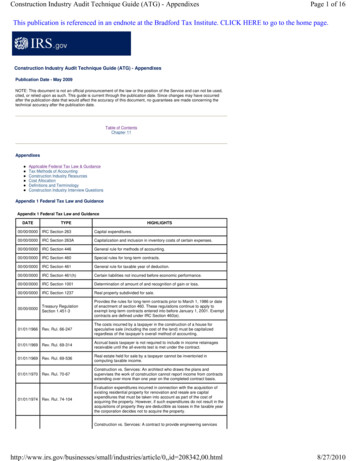
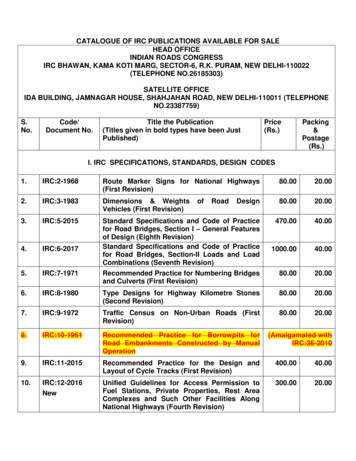

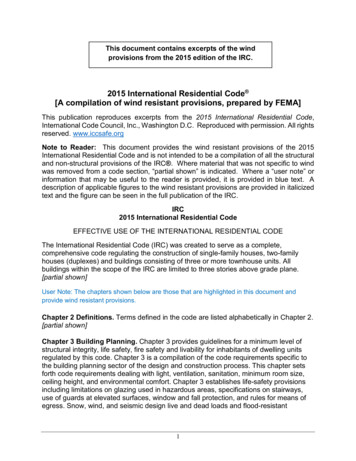
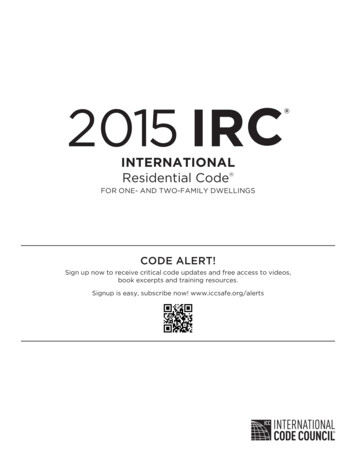
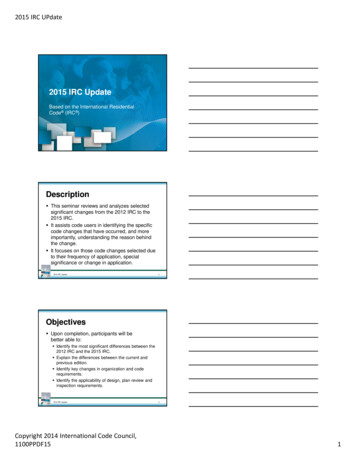
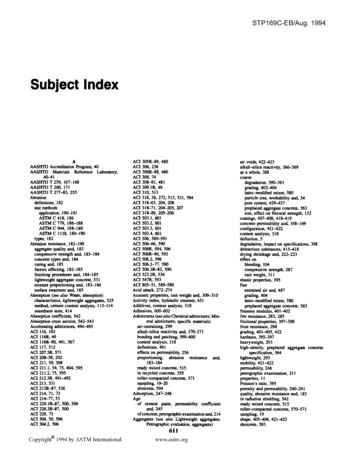
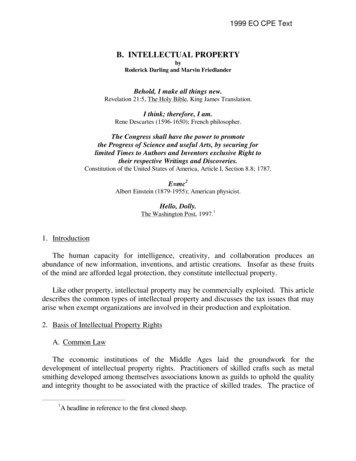

![(New) 2015 IRC Essentials [Read-Only]](/img/13/2015irc-essentials-highlights.jpg)
